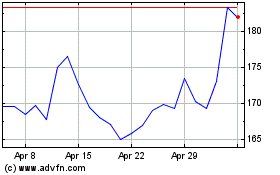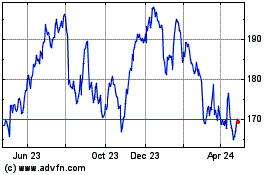Apple Exempt Solicitation
Notice of Exempt Solicitation (Voluntary Submission)
Pursuant to Rule 14a-103
Name of the Registrant: Apple Inc.
Name of persons relying on exemption: Nia Impact Capital
Address of persons relying on exemption: 4900 Shattuck Ave #3648, Oakland,
CA 94609
Written materials are submitted pursuant
to Rule 14a-6(g)(1) promulgated under the Securities Exchange Act of 1934. Submission is not required of this filer under the terms of
the Rule, and is made voluntarily.
The proponent urges you to vote FOR the stockholder proposal requesting
that the Apple Board adopt a policy that a Board member will meet with a proponent of a shareholder resolution, should that resolution
receive a majority of support from non-insider shares. This is Proposal Seven at the Apple Annual Meeting of Shareholders on March 10,
2023.
SUMMARY OF THE PROPOSAL
The resolution requests that the Apple Board adopt a policy that, should
holders of a majority of non-insider shares support a shareholder proposal, at least one Board member will be made available for a discussion
with the proposal's proponents.
The resolution supports this request by noting the belief that a high
vote for a shareholder proposal indicates that investors’ concerns have not yet been successfully addressed by the company’s
management or Board. The resolution also notes that Apple’s Corporate Governance Guidelines explicitly state that it is only in
“unusual circumstances” that individual directors will be authorized to speak with investors or other stakeholders.
The resolution also provides an example of Apple’s Board being
insufficiently responsive to a proponent of a shareholder resolution which had received majority support and where the resolution’s
proponent and other investors did not believe that management was effectively addressing the issue of concern. The proponent had been
unable to access Board members to discuss their concerns with management.
RATIONALE FOR SUPPORT OF THE PROPOSAL
Support for this resolution is warranted given that:
| 1) | In the proponent’s view, the Board’s primary responsibility is to the investor |
| 2) | Apple’s management acts as a gatekeeper between investors and the Board |
| 3) | Management’s interests may diverge from those of the Board and Apple investors |
| 4) | A majority vote indicates investors seek a more vigorous response from Apple |
| 5) | The change requested, asking the Board to take limited steps to increase its understanding of concerns held by a majority of investors,
is not overly burdensome |
The Board’s primary responsibility
is to the investor.
Many market participants, including the proponent,
believe that the Board’s primary responsibility is to the investor, not to management. For example, as defined by the CFA Institute,
FINRA and the SEC, a key Board responsibility is to provide oversight of management:
| ● | “Among its many roles, a board of directors is responsible for establishing accountability for company management and assuring
reasonable internal controls through independent third-party reviews of the company.”1
– CFA Institute |
| ● | “Chosen by shareholders, the primary job of a public company’s board of directors is to look out for the shareholders’
interests. In fact, directors are legally required to put shareholders’ interests ahead of their own. The board plays a supervisory
role, overseeing corporate activities and assessing performance. Directors are responsible for hiring and firing top managers, and for
setting their compensation.”2 – FINRA |
| ● | “A Board with the necessary knowledge, experience and expertise can properly perform its task of overseeing management and governance
of the corporation, formulating the corporation’s vision, mission, strategic objectives, policies and procedures that would guide
its activities, effectively monitoring management’s performance and supervising the proper implementation of the same.”3
- SEC |
Apple’s management acts as a gatekeeper between investors
and the Board
Despite these responsibilities to investors, Apple's Board has a formal
policy to defer to management, undermining its ability to provide robust oversight of these same managers. Its Corporate Governance Guidelines
empower management to serve as a key gatekeeper between Apple’s investors and its Board. These Guidelines state:
The Board believes that management
speaks for the Corporation. Each director will refer inquiries from investors, customers, analysts, the press, and other constituencies
to management for response. Absent unusual circumstances or as contemplated by the committee charters, individual directors will only
speak on behalf of the Corporation with investors, analysts, the press, and other constituencies about the Corporation at the request
of management or if authorized by the Chair of the Board, the Lead Director (if any), or the Board and in accordance with the Corporation’s
policies.4
Management’s interests may diverge from that of the Board
and Apple investors
A key reason board oversight is so important is that management’s
interests may diverge from those of Apple’s investors. It is essential that, should management's performance be subpar or should
managers obfuscate issues presented to the Board, there be a recourse for investors to discuss concerns directly with the Board.
A majority vote indicates that investors seek a more vigorous response
from Apple
Apple's statement in opposition to this proposal states, “On
many occasions, Apple has been able to satisfactorily respond to questions, enhance its disclosures, or adjust its policies or practices
to resolve questions or concerns raised by a shareholder, eliminating any need for a proposal to be put to a vote by shareholders.”
When a proposal goes to a vote, it means that these conversations have
been unsuccessful. It is reasonable to interpret that, if management met with the resolution’s proponent prior to the printing of
the proxy statement and the proponent chose not to withdraw the proposal, that the proponent believes management’s actions remain
insufficient. Similarly, when a resolution receives support from a majority of shares voted, this suggests that the desires of investors
have not been satisfied by the actions of management.
1
https://www.cfainstitute.org/en/advocacy/issues/board-structure#sort=%40pubbrowsedate%20descending
2
https://www.finra.org/investors/insights/get-board-understanding-role-corporate-directors
3
https://www.sec.gov.ph/wp-content/uploads/2019/11/2016_memo_circular_no.19.pdf
4
https://s2.q4cdn.com/470004039/files/doc_downloads/gov_docs/Corporate-Governance-Guidelines.pdf
When this occurs, it is important that investors are able to meet directly
with a Board member, regardless of management's preferences. The Board should hear directly about investors’ concerns, rather than
have them filtered through a management representative.
Unfortunately, a disconnect in communication between investors and
the Board is not a hypothetical concern at Apple. As Apple's statement in opposition to this proposal states, “Apple management
sought to engage with the proponent multiple times, and the proponent declined to engage each time.”
As a result of conflicting data provided by management and the media,5
the proponent of this resolution, Nia Impact Capital (Nia), felt it would be unproductive to have additional conversations with management
about Apple’s use of concealment clauses,6
the topic of concern for Nia's resolution in 2022 which received majority support. Rather, Nia believed the board's oversight of Apple's
use of concealment clauses to be a corporate governance concern that is directly connected to Apple's diversity, equity, and inclusion
goals. In addition, as concealment clauses are often used to protect managers against claims from employees, to the possible detriment
of the company and investors, it was important to Nia that the sole representative to investors of Apple’s approach to the use of
these clauses not be a member of management.
Nia and supporting institutional investors wrote both formal and informal
requests to Apple, requesting a meeting with a Board member. The Board’s lack of response, together with repeated offers for additional
meetings with management, catalyzed Nia’s filing of this shareholder resolution. It was not until after Nia filed this proposal,
and nine months after its resolution received a majority vote, that Nia was able to speak with a Board member.
Although Nia eventually obtained its desired meeting with a director,
the policy urged in this proposal could benefit other Apple shareholders. A proponent whose resolution received majority support should
not be required to pursue the same process Nia did in order to speak directly with Apple's Board.
The change requested, asking the Board to take limited steps to
increase its understanding of concerns held by a majority of investors, is not overly burdensome
This resolution requests a corporate governance policy change at Apple
which will make Board members slightly more accessible in very limited circumstances. At Apple, two majority votes were obtained on shareholder
proposals at the 2022 annual meeting;7 however,
no shareholder proposal achieved majority support in 2021,8
2020,9 2019,10
2018,11 2017,12
2016,13 2015,14
2014,15 or 2013.16
A mechanism that would have been triggered twice in the last ten years and provides an important avenue for investors and their ability
to communicate concerns directly to the Board, should not be considered disruptive or onerous to Board members..
5
https://www.businessinsider.com/apple-sec-response-under-scrutiny-after-whistleblower-comes-forward?r=US&IR=T
6
Concealment clauses are defined as any employment or post-employment agreement, such as arbitration, non-disclosure
or non-disparagement agreements, that Apple asks employees or contractors to sign which would limit their ability to discuss unlawful
acts in the workplace, including harassment and discrimination.
7 https://www.sec.gov/ix?doc=/Archives/edgar/data/0000320193/000119312522066169/d294699d8k.htm
8
https://www.sec.gov/ix?doc=/Archives/edgar/data/0000320193/000119312521054710/d101693d8k.htm
9
https://www.sec.gov/ix?doc=/Archives/edgar/data/0000320193/000119312520050884/d865740d8k.htm
10
https://www.sec.gov/Archives/edgar/data/320193/000032019319000032/copyofreference8-kform8xkq.htm
11
https://www.sec.gov/Archives/edgar/data/320193/000119312518045761/d374908d8k.htm
12
https://www.sec.gov/Archives/edgar/data/320193/000119312517064019/d342218d8k.htm
13
https://www.sec.gov/Archives/edgar/data/320193/000119312516488223/d150918d8k.htm
14
https://www.sec.gov/Archives/edgar/data/320193/000110465915019336/a15-5624_18k.htm
15
https://www.sec.gov/Archives/edgar/data/320193/000119312514084697/d684095d8k.htm
16
https://www.sec.gov/Archives/edgar/data/320193/000119312513085842/d493940d8k.htm
In opposition to this resolution, the Board has stated that “the
proposal is overly prescriptive and would detract from the Board’s ability to effectively discharge its duties by restricting when,
how, and through whom shareholder engagement is conducted.” The resolution does not request that Board members restrict their shareholder
engagement. The resolution simply asks for a conversation between a Board member and a resolution’s proponent, should that resolution
receive support from a majority of external investors. The resolution does not require any specific action from the Apple Board, beyond
a conversation which would provide the Board with context to better understand the concerns of the company’s investors.
---
This shareholder resolution was filed by Nia Impact Capital and co-filed
by the Minderoo Foundation. For questions regarding Proposal Seven, please contact Meredith Benton, benton@whistlestop.capital, (415)
384-9895.
__
The foregoing information may be disseminated to shareholders via telephone,
U.S. mail, e-mail, certain websites and certain social media venues, and should not be construed as investment advice or as a solicitation
of authority to vote your proxy. The cost of disseminating the foregoing information to shareholders is being borne entirely by the resolution
filer.
Please do not send us your proxy card; Nia Impact Capital is not able
to vote your proxies, nor does this communication contemplate such an event. To vote your proxy, please follow the instructions in Apple’s
proxy statement.
4
Apple (NASDAQ:AAPL)
Historical Stock Chart
From Mar 2024 to Apr 2024

Apple (NASDAQ:AAPL)
Historical Stock Chart
From Apr 2023 to Apr 2024
